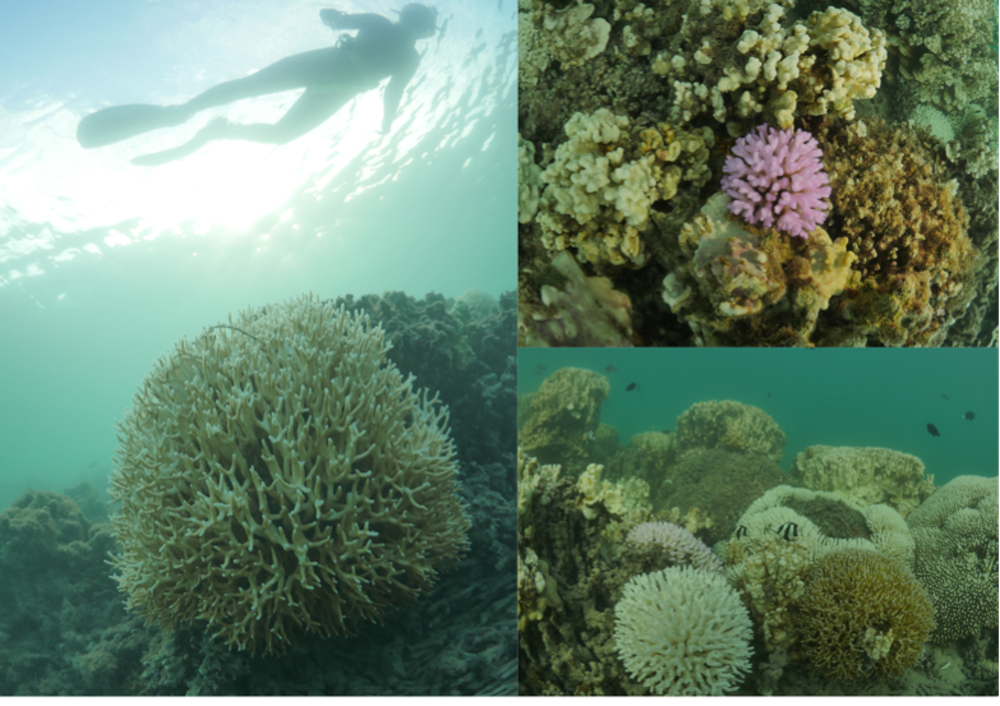
This month, corals in Australia's Lord Howe Island Marine Park began showing signs of bleaching. The 145,000-hectare marine park contains the most southerly coral reef in the world, in one of the most isolated ecosystems on the planet.
Following early reports of bleaching in the area, researchers from three Australian universities and two government agencies worked together throughout March to investigate and document the bleaching.
Sustained heat stress has seen 90 percent of some reefs bleached, although other parts of the marine park have escaped largely unscathed.
Bleaching is uneven
Lord Howe Island was named a UNESCO World Heritage Site in 1982. It is the coral reef closest to a pole,and contains many species found nowhere else in the world.
Two of us (Tess Moriarty and Rosie Steinberg) have surveyed reefs across Lord Howe Island Marine Park to determine the extent of bleaching in the populations of hard coral, soft coral and anemones. This research found severe bleaching on the inshore lagoon reefs, where up to 95 percent of corals show signs of extensive bleaching.
However, bleaching is highly variable across Lord Howe Island. Some areas within the Lord Howe Island lagoon coral reef are not showing signs of bleaching and remained healthy and vibrant throughout the summer. Corals on the outer reef and at deeper reef sites have also remained healthy, with minimal or no bleaching.
One surveyed reef location in Lord Howe Island Marine Park is severely impacted, with more than 90 percent of corals bleached; at the next most affected reef site, roughly 50 percent of corals are bleached, and the remaining sites are less than 30 percent bleached. At least three sites have less than 5 percent bleached corals.
Over the past week, heat stress has continued in this area, and return visits to these sites revealed that the coral condition has worsened. There is evidence that some corals are now dying on the most severely affected reefs.
Forecasts for the coming week indicate that water temperatures are likely to cool below the bleaching threshold, which will hopefully provide timely relief for corals in this valuable reef ecosystem. In the coming days, weeks and months, we will continue to monitor the affected reefs and determine the impact of this event to the reef system, and investigate coral recovery.
What's causing the bleaching?
The bleaching was caused by high seawater temperature from a persistent summer marine heat wave off southeastern Australia. The temperature in January was a full degree Celsius warmer than usual, and from the end of January to mid-February temperatures remained above the local bleaching threshold.
Sustained heat stressed the Lord Howe Island reefs and put them at risk. They had a temporary reprieve with cooler temperatures in late February, but by March another increase put the ocean temperature well above safe levels. This is now the third recorded bleaching event to have occurred on this remote reef system.
However, this heat wave has not equally affected the whole reef system. In parts of the lagoon areas the water can be cooler, due to factors like ocean currents and fresh groundwater intrusion, protecting some areas from bleaching. Some coral varieties are also more heat-resistant, and a particular reef that has been exposed to high temperatures in the past may better cope with the current conditions. For a complex variety of reasons, the bleaching is unevenly affecting the whole marine park.
Coral bleaching is the greatest threat to the sustainability of coral reefs worldwide and is now clearly one of the greatest challenges we face in responding to the impact of global climate change. UNESCO World Heritage regions, such as the Lord Howe Island Group, require urgent action to address the cause and impact of a changing climate, coupled with continued management to ensure these systems remain intact for future generations.
The authors thank ProDive Lord Howe Island and Lord Howe Island Environmental Tours for assistance during fieldwork.
Tess Moriarty, PhD candidate, University of Newcastle; Bill Leggat, associate professor, University of Newcastle; C. Mark Eakin, coordinator, Coral Reef Watch, National Oceanic and Atmospheric Administration; Rosie Steinberg, PhD student, UNSW; Scott Heron, senior lecturer, James Cook University; and Tracy Ainsworth, associate professor, UNSW.
This article is republished from The Conversation under a Creative Commons license. Read the original article.
Uncommon Knowledge
Newsweek is committed to challenging conventional wisdom and finding connections in the search for common ground.
Newsweek is committed to challenging conventional wisdom and finding connections in the search for common ground.
About the writer
To read how Newsweek uses AI as a newsroom tool, Click here.








